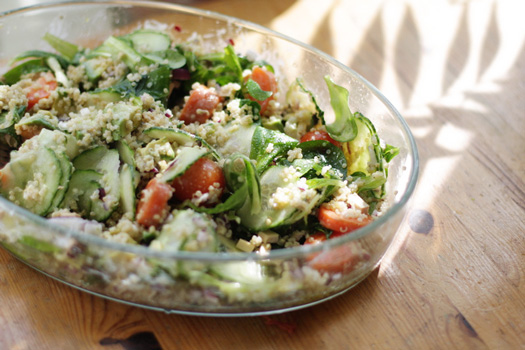Can the hostile environment in which quinoa (pronounced “KeenWa”) is grown account for its high nutritional content? Quinoa is a stable food of the Incas and the Indians of Peru, Ecuador and Bolivia. Today, most quinoa is grown in the high altitude plains of Bolivia, in what would be considered by most farmers infertile, arid ground. The wind-blown sandy plains of Bolivia, nearby salt flats, and dung from grazing sheep provide the perfect environment and minerals to make quinoa a superfood!
Here in the America, quinoa has quickly become as popular as brown rice! And although it may be considered a grain, it is actually a seed produced within the cone-shaped flowers of a quinoa plant.
For many years brown rice has been viewed as a “health food” because of its whole grain status. However, its nutritional profile cannot compare to the nutrients the arid ground, sheep dung, and salt flats have packed into quinoa!
If quinoa and brown rice had a nutrient fight, quinoa would win hands down. Here is the nutritional matchup per 1 cup serving and/or recommended daily allowance (RDA):
Calories, Protein and Fiber
- Quinoa and brown rice are an equal match in calories.
- Quinoa provides 21% of the RDA of fiber, while brown rice provides 14%.
- Quinoa has 8.1 grams of protein (with all amino acids making it a complete protein), while brown rice contains 5 grams of protein (no amino acids).
B-Vitamins
- Quinoa and brown rice are both good sources of vitamin B1.
- Quinoa provides 12% of the RDA of vitamin B2, while brown rice provides 3%.
- Quinoa provides 19% of the RDA of folate, while brown rice provides 2%.
- Brown rice provides 15% of the RDA of B3, while Quinoa provides 4%.
Minerals
- Quinoa provides 13% of the RDA of zinc, while brown rice provides 8%.
- Quinoa provides 15% of the RDA or 2.8 mg of plant based iron, while brown rice provides 5% of the RDA.
- Brown rice provides 27% of the RDA of selenium, while Quinoa provides 7%.
Quinoa is not only transforming the health status of many Americans with its rich nutrient profile, it is also changing the lives of those responsible for its growth and harvest. Ernesto Choquetopa is a farmer in Bolivia. According to Ernesto, quinoa’s popularity in the U.S. has afforded him the opportunity to send his daughter to medical school with his earnings. Ernesto says this about life before and since the popularity of his native crop: “People didn’t go to study. They were born, they grew up, and that was it. They went on to herd sheep and llamas. Nothing more. Now people here, we think about doing something with our lives.” Positive transformation is good especially when it reaches outside the borders of the United States—the land of plenty—and touches the lives of farmers, like Ernesto, who work hard to provide Americans with nutritious food.
Quinoa is as versatile as it is nutritious. Today, quinoa is enjoyed year-round, hot or cold. In the winter months I add quinoa to soup or bone broth to boost medicinal properties. Writings of Dr. Weston A. Price in 1930 noted that Indians of the Andes Mountains would make a gruel made of quinoa for nursing mothers because of its high protein content. But to ensure that the nutritional content of this super seed can be absorbed, it is necessary to neutralize the anti-nutrient—phytic acid—by soaking it for a minimum of 12 hours before cooking.
Quinoa also makes an excellent summer meal. Not only is it light, it is quite tasty cold. Below is a nice salad that can be enjoyed on those “hot, dog days” of summer.
Quinoa, Tomato Salad with Garlic Pesto
Makes 4 servings
Ingredients
1 cup cherry currant tomatoes, cut in half
2 large heirloom tomatoes, cut into 1/2-inch chunks
2/3 cup crumbled feta cheese
1 cup quinoa
2 cups water
3-4 tablespoons lemon juice
Sea salt and freshly ground pepper to taste
Pesto
1 cup packed fresh basil leaves
2 cloves garlic; peeled
2 tablespoons lemon juice
1/4 to 1/2 cup extra virgin olive oil
1/4 cup toasted pine nuts
Salt and freshly ground pepper to taste
Pulse all ingredients (except salt and pepper) in food processor until smooth. Remove to a bowl and season with salt and pepper. Pesto will keep 1 week in an air-tight container.
Salad
Rinse quinoa well under cold water (soaking optional). Set quinoa in heavy-bottomed saucepan and cover with cold water. Bring to a boil, cover, and simmer until tender, about 15 minutes.
Strain in a fine colander and cool. Combine quinoa, feta and tomatoes and toss with just enough pesto to coat. Season with salt, pepper, and lemon juice to taste.
References:
Nourishing Traditions by Sally Fallon with Mary G. Enig, PhD.
Huffington Post – www.huffpostliving.ca posted 7/12/2013.
NPR.org Special Series Kitchen Window, September 17, 200






